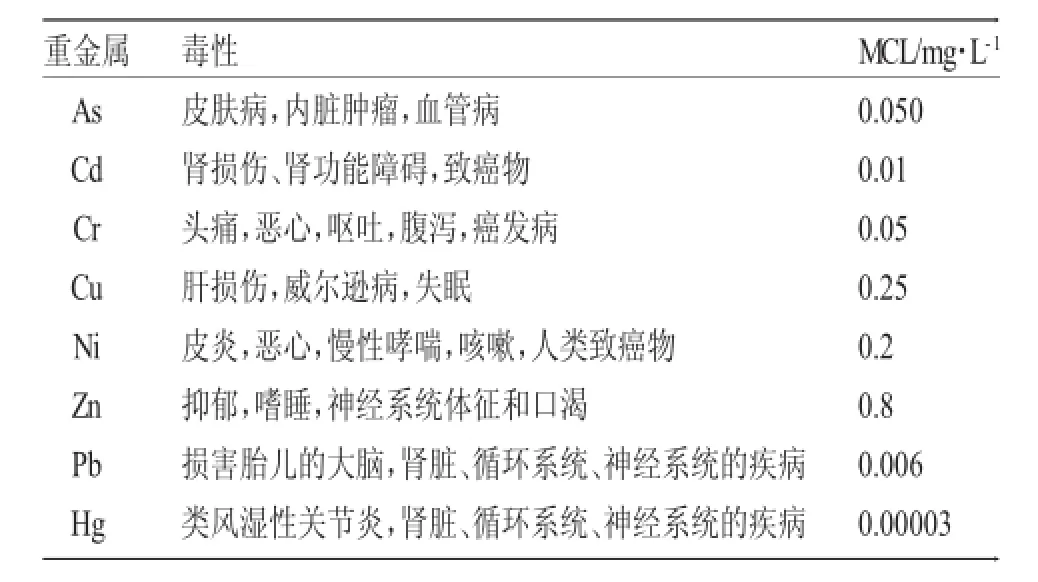新型吸附剂处理水体中重金属离子的研究进展*
陈佑宁,赵 维,曹 蕾
(咸阳师范学院化学与化工学院,陕西咸阳712000)
新型吸附剂处理水体中重金属离子的研究进展*
陈佑宁,赵维,曹蕾
(咸阳师范学院化学与化工学院,陕西咸阳712000)
简述了水体中重金属污染现状及处理方法,综述了各类新型吸附剂在含重金属废水处理中的最新研究进展和技术应用,指出了目前吸附法在含重金属废水处理中存在的问题,同时对未来新型吸附剂的研究方向进行了展望。
新型吸附剂;重金属离子;研究进展
1 水体重金属污染现状及危害
金属污染工业废水的大量排放,造成了重金属离子(如Cd,Cr,Cu,Ni,As,Pb和Zn)对水、土壤和食物的严重污染。由于其在水体中的高溶解性,重金属离子被生物体吸附后进入生态系统,经食物链的生物放大作用,逐级在较高级的生物体内富集,引起生态系统中各级生物的不良反应,甚至危害包括人体在内的各种生命体的健康与生存。如果摄入的重金属离子超过允许浓度,将会引起严重的疾病。表1为部分重金属的危害及其最大污染水平(MaximumContaminant Level,MCL)标准[1]。
从污染源来看,环境中的重金属主要来自以下几个方面:矿山的开采、机械加工、燃烧化石燃料,焚烧废物,汽车废气,冶炼过程及利用污水污泥作为填埋材料和肥料等等,将大量具有潜在毒性的重金属离子引入到大气、水生和陆生环境中,排出的有毒金属通常包括镉,铜,镍,铬,钴,锌和铅。

表1 部分有害重金属离子的MCL标准Tab.1MCL standard of harmful heavy metal
进入环境中的重金属只能从一种形态转化为另一种形态,从一个地方迁移到另一个地方,而无法从环境中消失。即使对污染源进行有效的控制,已经污染的环境危害性仍会长期存在。
表2为部分金属的工业来源和潜在污染。
从表2可以看出,水污染是产生重金属污染的一个主要途径。因此,近年来,工业废水的处理问题日益引起国内外科研工作者的关注。

表2 环境中重金属的来源Tab.2Resource of heavy metal in environment
2 水体重金属离子处理方法
去除废水中重金属离子的方法很多,包括化学沉淀/混凝法、膜技术法、电解还原法、离子交换法和吸附法[2,3](表3)。这些方法原理不同,各有优缺点。

表3 废水中重金属离子的去除方法及其优缺点Tab.3Removal method and merits and demerits
在所有这些处理方法中,吸附法具有成本低、效果好、可操作性强的优点成为重金属离子工业废水处理应用中一种重要的物理化学方法[4]。物质在固体表面上或孔隙容积内积聚的现象被称为吸附,分为物理吸附和化学吸附两种。在物理吸附过程中,被吸附分子的化学性质保持不变,而化学吸附过程可以看成为相界面上发生的化学反应,相互作用的成分间发生电子重新分配,并形成化学键[5]。通常,一个吸附过程分为4步:(1)吸附质从溶液中向吸附剂表面扩散;(2)吸附质同吸附剂外表面活性点的相互作用;(3)内部扩散过程,通常由吸附剂的孔径决定;(4)吸附质同吸附剂内表面活性点的吸附作用。其中吸附质同吸附剂表面活性点之间可能发生化学吸附(强吸附质-吸附剂作用,相当于共价键的形成)或者弱的吸附(弱吸附质-吸附剂作用,与范德华力非常类似),影响吸附选择性和吸附容量,进而影响吸附效率。因此,在重金属子工业废水处理过程中,采用高性能吸附剂是提高水处理效果的关键。
3 新型吸附剂研究进展
一般来说,一切固体物质的表面都具有吸附作用,实际上只有具有较大比表面积且具有相应活性的多孔材料才有明显的吸附作用,可用作吸附剂。目前,已开发以下几类吸附剂:(1)非离子型;(2)生物亲和型;(3)金属阳离子配位型;(4)离子交换型吸附剂。其中,非离子型和生物亲和型吸附剂主要用于吸附有机污染物,通常采用金属阳离子配位型和离子交换型吸附剂去除溶液中的重金属离子。离子交换型吸附剂鉴于离子交换作用原理,能有效分离各种离子,但缺乏选择性。与离子交换吸附剂相比,螯合剂与金属离子的结合能力更强、选择性更高。因而,开发具有螯合吸附功能的吸附剂是吸附剂研究的一个重要内容。
螯合剂由两部分组成:基质和表面功能基团。所选择的基质必须满足一定要求:(1)具有一定孔隙度;(2)比表面积大;(3)机械强度好;(4)化学稳定好;(5)价廉易得。在重金属废水处理过程中,应用的基质有活性炭、黏土等无机吸附材料,木质素、壳聚糖等天然高分子吸附材料,硅胶基树脂、聚苯乙烯树脂等合成高分子吸附材料[6]。含不同基质的各种吸附材料性能比较见表4。
其中,合成高分子材料具有多孔性、具有较大的比表面积、较好的机械强度以及物理化学稳定性,被广泛用作重金属离子吸附材料的基体,包括酚醛树脂基吸附材料、聚丙烯腈吸附材料、聚丙烯酸酯吸附材料以及聚苯乙烯基吸附材料等。由于酚醛树脂中含有大量酚羟基,使得在酚环上进行化学改性受到了很大的限制;对聚丙烯腈纤维进行功能化,腈基转化率和功能基含量不高,限制了吸附容量的提高;聚丙烯酸酯基体生产成本高,从而限制了它的应用。

表4 含不同基质的各种吸附材料性能比较Tab.4Comparison of different materials property
由于聚苯乙烯树脂生产成本低、孔隙率高、比表面积大以及耐酸碱和有机溶剂,以聚苯乙烯树脂为基体的螯合树脂是一类研究最广泛、使用最多的金属离子吸附材料。聚苯乙烯采用悬浮聚合工艺合成,以水为反应介质,在引发剂和分散剂的作用下聚合得到多孔珠状颗粒。聚苯乙烯的分子链上交替连接着侧苯基(图1),侧苯基的存在加大了聚苯乙烯的化学活性,可以进行硝化、磺化、氯化等反应。一般以聚苯乙烯为骨架,利用傅克反应,在芳环上引入-CH2Cl、-SO3H等基团制备氯甲基化和磺化聚苯乙烯。氯甲基化聚苯乙烯(图2)中的-CH2Cl具有高度的反应活性,易与多电子的原子结合,可进一步发生多种反应,从而在高分子链中引入多种功能基团。通过对氯甲基化聚苯乙烯微球(简称氯球)进行表面修饰,可以制备离子交换树脂和螯合树脂,可以合成用于有机合成与组合化学体系的催化剂载体,可制备用于分离和纯化生物大分子的功能高分子微球以及色谱固定相[8-11]。

图1 聚苯乙烯Fig.1Polystyrene

图2 氯甲基化聚苯乙烯Fig.2Chloromethylated polystyrene
吸附剂表面的功能基不仅影响吸附选择性,也影响吸附机理。具有羧基、磺酸基和磷酸基的吸附剂通过离子交换作用进行吸附[11-15],而那些包含氮原子的吸附剂,如胺、肼、硫代酰胺、咪唑等[16-19],不仅可以通过螯合作用吸附阳离子,还可以通过静电相互作用吸附阴离子。从环境保护角度看,开发一些对某些重金属离子有选择性吸附的新型功能基团具有较大研究价值,大量研究致力于通过将某些材料(如活性炭[20,21]、螯合树脂[22,23]、硅胶[24,25]等)进行功能化开发一些新型吸附剂(表5)。
通过在基体表面引入各种功能基团,提高了材料的吸附性能。由于聚合物分子中存在立体效应、静电作用、协同作用以及功能基的稀释和浓缩等高分子效应,螯合树脂对重金属离子的吸附容量高于小分子的有机螯合试剂。螯合树脂能够与金属离子形成配位络合物,对重金属离子具有较好的吸附性能,在重金属废水的处理领域具有潜在应用前景[44-46]。螯合树脂的骨架均为体形结构,耐酸、碱、水和其他有机溶剂,分离十分方便,因此,被广泛应用于富集、分离、分析、回收金属离子、脱除工业污水中的金属离子等方面。特别是近几年来重金属离子对水质的污染、化学工业污水的净化处理等问题日益严重,地球化学、环境保护学等领域对螯合树脂的要求越来越高,利用螯合树脂处理含重金属离子的工业废水不仅改善了人类的生活环境,同时又可以从工业废物中分离回收有用的物质,充分利用资源,提高经济效益。
4 结语
重金属离子吸附过程中,树脂表面所含功能基团的种类、功能基团在树脂表面的密度以及功能基团与金属离子之间的相互作用,都会对吸附容量和吸附选择性产生影响。开发与特定重金属离子能产生特异性结合的螯合功能团是实现选择性吸附的关键;选择合适的表面改性方法,增大树脂表面功能基团的密度是提高吸附容量的重要途径。今后,对于高性能螯合树脂的研究,应该主要集中在以下两个方面:(1)由于螯合树脂对金属离子的吸附主要依靠树脂表面的功能基团与金属离子的相互作用,因此,设计采用新型功能基团对基质进行改性,该方面研究一直是、相信未来也是螯合树脂研究的重点之一;(2)由于树脂对金属离子的吸附容量和吸附选择性不仅与功能基团种类有关,还与树脂表面功能基键合密度有关,因此,使用能够控制材料表面功能基键合密度的表面修饰新方法。

表5 各种功能化吸附材料对重金属离子的吸附Tab.5Absorbent of sorbing material on heavy metal
[1]Bansode P.R.,Losso J.N.,Marshall W.E.,et al.Adsorption of metal ionsbypecanshell-basedgranularactivatedcarbons[J].Bioresource Technology,2003,89:115-119.
[2]Kurniawan T.A.,Chan G.Y.S.,Lo W.H.,et al.Physicochemical treatment techniques for wastewater laden with heavy metals[J]. Chemical EngineeringJournal,2006,118(1-2):83-98.
[3]WangY.H.,Lin S.H.,JuangR.S..Removal of heavymetal ions from aqueous solutions using various low-cost adsorbents[J].Journal of Hazardous Materials,2003,102(2-3):291-302.
[4]Vinodh R.,Padmavathi R.,Sangeetha D..Separation ofheavymetals from wateramples using anion exchange polymers by adsorption process[J].Desalination,2011,267:267-276.
[5]Kurniawan T.A.,Babel S..A research study on Cr(VI)removal from contaminated wastewater using low-cost adsorbents and commercial activated carbon[J].Proceedings of the 2nd Regional Conference on EnergyTechnologyTowards a Clean Environment,2003: 1110-1117.
[6]曲荣君.金属离子吸附材料:制备、结构、性能[M].北京:化学工业出版社,2009.
[7]Wang L.Y.,Yang L.Q.,Li Y.F.,et al.Study on adsorption mechanism of Pb(II)and Cu(II)in aqueous solution using PS-EDTA resin[J].Chemical EngineeringJournal,2010,163:364-372.
[8]Ansari S.A.,Mohapatra P.K.,Manchanda V.K..Anovel malonamide grafted polystyrene-divinyl benzene resin for extraction,pre-concentration and separation ofactinides[J].Journal ofHazardous Materials,2009,161:1323-1329.
[9]Bayramoglu G.,Yavuz E.,Senkal B.F.,et al.Glycidyl methacrylate grafted on p(VBC)beads by SI-ATRP technique:Modified with hydrazine as a salt resistance ligand for adsorption of invertase[J]. Colloids and Surfaces a-physicochemical and engineering aspects, 2009,345:127-134.
[10]Zhang R.Y.,Yang G.L.,Xin P.Y.,et al.Preparation of poly(N-isopropylacrylamide)-grafted polymer monolith for hydrophobic interaction chromatography of proteins[J].Journal of ChromatographyA,2009,1216:2404-2411.
[11]Cheng T.W.,Lee M.L.,Ko M.S.,et al.The heavy metal adsorption characteristics on metakaolin-based geopolymer[J].Applied Clay Science,2012,56:90-96.
[12]Anirudhan T.S.,Jalajamony S.,Sreekumari S.S..Adsorption of heavymetal ions fromaqueous solutions byamine and carboxylate functionalised bentonites[J].Applied Clay Science,2012,65-66 :67-71.
[13]SonmezH.B.,Senkala B.F.,Sherringtonb D.C.,et al.Atomtransfer radical graft polymerization of acrylamide from N-chlorosulfonamidated polystyrene resin,and use of the resin in selective mercuryremoval[J].Reactive&Functional Polymers,2003,55:1-8.
[14]Othman C.S.A.H.,Shaikh A.A..Removal of heavy metal ions using a novel cross-linked polyzwitterionic phosphonate[J].Separation and Purification Technology,2012,98:94-101.
[15]Eloueara Z.,Bouzida J.,et al.Heavy metal removal from aqueous solutions byactivated phosphate rock[J].Journal of HazardousMaterials,2008,156:412-420.
[16]Dana E.,Sayari A..Adsorption of copper on amine-functionalized SBA-15 prepared by co-condensation:equilibrium properties[J]. Chemical EngineeringJournal,2011,166:445-453.
[17]HatayR.Gup M.E..Silica gel functionalized with 4-phenylacetophynone4-aminobenzoylhydrazone:Synthesis of a new chelating matrix and its application as metal ion collector[J].Journal of Hazardous Materials,2008,150:546-553.
[18]Ravikumar L.,Kalaivani S.S.,Murugesan A.,et al.Synthesis, characterization,and heavymetal ion adsorption studies ofpolyamides,polythioamides having pendent chlorobenzylidine rings[J]. JournalofAppliedPolymerScience,2011,122:1634-1642.
[19]Tu J.,Zhou J.,WangC.F.,et al.Facile synthesis ofN-vinylimidazole-based hydrogels via frontal polymerization and investigation of their performance on adsorption of copper ions[J].Journal of Polymer Science Part a-polymer Chemistry,2010,48:4005-4012.
[20]Choi H.D.,JungW.S.,Cho J.M.,et al.Adsorption of Cr(VI)onto cationic surfactant-modified activated carbon[J].Journal of Hazardous Materials,2009,166:642-646.
[21]Zhu J.Z.,YangJ.,DengB.L..Enhanced mercuryion adsorption by amine-modified activated carbon[J].Journal of Hazardous Materials,2009,166:866-872.
[22]Jing X.S.,Liu F.Q.,Yang X.,et al.Adsorption performances and mechanisms of the newly synthesized,N'-di(carboxymethyl)dithiocarbamate chelating resin toward divalent heavy metal ions fromaqueousmedia[J].JournalofHazardousMaterials,2009,167: 589-596.
[23]Zhang Y.,Qu R.J.,Sun C.M.,et al.Comparison of synthesis of chelating resin silica-gel-supported diethylenetriamine and its removal properties for transition metal ions[J].Journal of Hazardous Materials,2009,163:127-135.
[24]Kumar G.P.,Kumar P.A.,Chakraborty S.,et al.Uptake and desorption of copper ion using functionalized polymer coated silica gel in aqueous environment[J].separation and purification technology,2007,57:47-56.
[25]Hatay R.G..Silica gel functionalized with 4-phenylacetophynone 4-aminobenzoyl hydrazone:synthesis of a new chelating matrix and its application as metal ion collector[J].Journal of Hazardous Materials,2008,150:546-553.
[26]Othman C.S.A.H.,Shaikh A.A..Removal ofheavymetal ions usinga novel cross-linked polyzwitterionic phosphonate[J].Separation and Purification Technology,2012,98:94-101.
[27]Anirudhan T.S.,Jalajamony S.,Sreekumari S.S..Adsorption of heavymetal ions fromaqueous solutions byamine and carboxylate functionalised bentonites[J].Applied Clay.Science,2012,65-66: 67-71.
[28]Lo S.F.,Wang S.Y.,Tsai M.J.,et al.Adsorption capacity and removal efficiencyofheavymetal ions byMosoand Ma bambooactivated carbons[J].Chemical Engineering Research and Design, 2012,90:1397-1406.
[29]Abdel-Nasser A.E.H..The role of surface chemistry and solution pH on the removal of Pb2+and Cd2+ions via effective adsorbents from low-cost biomass[J].Journal of Hazardous Materials,2009, 167:260-267.
[30]Sokker H.H.,Badawy S.M.,Zayed E.M.,et al.Radiation-induced grafting of glycidyl methacrylate onto cotton fabric waste and its modification for anchoring hazardous wastes from their solutions[J].Journal ofHazardous Materials,2009,168:137-144.
[31]Li X.S.,Liu S.L.,Na Z.Y.,et al.Adsorption,concentration,and recovery of aqueous heavy metal ions with the root powder of Eichhornia crassipes[J].Ecological Engineering,2013,60:160-166.
[32]Luo S.L.,Li X.J.,Chen L.,et al.Layer-by-layer strategy for adsorption capacity fattening of endophytic bacterial biomass for highlyeffective removal of heavymetals[J].Chemical Engineering Journal,2014,239:312-321.
[33]Li X.L.,Li Y.F.,Ye Z.F..Preparation of macroporous bead adsorbents based on poly(vinylalcohol)/chitosan and their adsorption properties for heavy metals from aqueous solution[J].Chemical EngineeringJournal,2011,178:60-68.
[34]KuangS.P.,WangZ.Z.,Liu J.,et al.Preparation of triethylene-tetramine grafted magnetic chitosan for adsorption ofPb(II)ion from aqueous solutions[J].Journal of Hazardous Materials,2013,260: 210-219.
[35]Huang Z.H.,Wu Q.L.,Liu S.X.,et al.A novel biodegradable β-cyclodextrin-based hydrogel for the removal f heavy metal ions[J].Carbohydrate Polymers,2013,97:496-501.
[36]Demirbilek C.,Dinc C.Ö..Synthesis of diethylaminoethyl dextran hydrogel and its heavy metal ion adsorption characteristics[J]. Carbohydrate Polymers,2012,90:1159-1167.
[37]Zhang Y.,Qu R.J.,Sun C.M.,et al.Comparison of synthesis of chelating resin silica-gel-supported diethylenetriamine and its removal properties for transition metal ions[J].Journal of Hazardous Materials,2009,163:127-135.
[38]Gao B.J.,Gao Y.C.,Li Y.B..Preparation and chelation adsorption propertyofcomposite chelatingmaterial poly(amidoxime)/SiO2towards heavy metal ions[J].Chemical Engineering Journal,2010, 158:542-549.
[39]Jing X.S.,Liu F.Q.,Yang X.,et al.Adsorption performances and mechanisms of the newly synthesized N,N/-di(carboxymethyl)dithiocarbamate chelating resin toward divalent heavy metal ions fromaqueous media[J].Journal ofHazardous Materials,2009,167: 589-596.
[40]Peng Y.H.,Wang J.N.,Yang X.,et al.Preparation of a novel chelating resin for the removal of Ni2+from water[J].Chinese Chemical Letters,2014,25:265-268.
[41]Serkan E.Preparation and characterization of an IPN type chelating resin containing amino and carboxyl groups for removal of Cu(II)from aqueous solutions[J].Reactive&Functional Polymers, 2014,75:63-74.
[42]Semmedu S.K.,Thangaraj V.,Arukkani M.,et al.The use of new modified poly(acrylamide)chelating resin with pendent benzothiazole groups containing donor atoms in the removalof heavy metal ions from aqueous solutions[J].Water Resources and Industry, 2014,5:21-35.
[43]Zhang Y.,Chen Y.N.,Wang C.Z.,et al.Immobilization of 5-aminopyridine-2-tetrazole on cross-linkedpolystyrene for the preparation of a new adsorbent to remove heavymetal ions from aqueous solution[J].Journal of Hazardous Materials,2014,276: 129-137.
[44]Zhang Y.,Qu R.J.,Sun C.M.,et al.Comparison of synthesis of chelatingresin silica-gel-supported diethylenetriamineand its removal properties for transition metal ions[J].Journal ofHazardous Materials,2009,163:127-135.
[45]Dinu M.V.,Dragan E.S.,Trochimczuk A.W..Sorption ofPb(II),Cd(II)and Zn(II)by iminodiacetate chelating resins innon-competitive and competitiveconditions[J].Desalination,2009,249:374-379.
[46]Meesri S.,Praphairaksit N.,Imyim A..Extraction and preconcentration of toxic metal ions from aqueous solution using benzothiazole-based chelatingresins[J].Microchemical Journal,2007,87:47-55.
Development of research on adsorption of heavy metal ions from wastewater by a new type of adsorbents*
CHEN You-ning,ZHAO Wei,CAO Lei
(College of Chemistry and Chemical Engineering,Xianyang Normal College,Xianyang 712000,China)
The present situation of heavy metal pollution in wastewater and its processing method are briefly described.The latest research development and technical of various new types of adsorbents to the removal of heavy metals from wasterwater are summarized.The problems existing in removing heavy metals from wasterwater by adsorption are pointed out and its future research direction is forecast.
new adsorbents;heavy metals;research progress
X703
A
10.16247/j.cnki.23-1171/tq.20161144
2016-05-03
陕西省教育厅专项科研计划项目(15JK1782)资助项目;咸阳师范学院专项科研基金项目(15XYYK037)资助项目
陈佑宁(1978-),咸阳师范学院化学与化工学院副教授,主要从事分离材料方面的研究。

